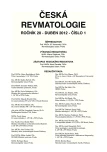Accurate diagnosis of various forms of renal osteopathy in chronic kidney disease - mineral and bone disorder
Authors:
K. Žamboch 1; J. Zahálková 2; Z. Kosatíková 1; P. Skýpalová 3; J. Škarda 3; J. Zadražil 1
Authors‘ workplace:
III. interní klinika-NRE, FN a LF UP v Olomouci
1; Nemocnice Šternberk, hemodialyzační oddělení, Středomoravská nemocniční, člen společnosti Agel, Šternberk
2; Ústav Patologie, FN a LF UP v Olomouci
3
Published in:
Čes. Revmatol., 20, 2012, No. 1, p. 20-28.
Category:
Original Papers
Overview
Background:
Targeted and safe treatment of chronic kidney disease – mineral and bone disorder (CKD-MBD) can be determined on the basis of comprehensive histomorphometry of particular forms of bone disease with the presence of ordinary components. In patients with high cardiovascular risk both extreme forms of renal osteopathy (RO) can be expected in a relatively high percentage according to the rate of bone turnover with a fundamentally different therapy for each form.
Objective:
The aim of this open, prospective pilot study is a comprehensive histomorphometry of renal osteopathy in chronic dialysis patients, assessment of the relationship between selected serum markers of bone resorption and formation and histomorphometric parameters of RO, and introduction of this method into routine practice in the high-risk group of patients with chronic renal insufficiency.
Patients:
12 chronic dialysis patients (N-12, 8 women and 4 men, average age 74 years, average duration of dialysis treatment 38 months) with high cardiovascular calcification index (CCI).
Methods:
Samples of bone tissue were obtained by trepanobiopsy and histomorphometrically evaluated using static and dynamic parameters of renal osteopathy. Static parameters include the determination of the volume and thickness of trabecular and spongiosa bone. Dynamic parameters were determined by identifying the tetracycline lines. Biochemical characteristics of the cohort included examination of serum markers related to bone formation and resorption. Other cohort characteristics comprised parathyroid gland volume, Z-score by DEXA examination, diagnosis of diabetes mellitus and duration of dialysis treatment.
Results:
Statistically significant positive correlations (p<0.01) were demonstrated between the volume of bone trabeculae and type I procollagen and calcitonin, between the osteoid thickness and type I procollagen and the trabecular bone volume and serum osteocalcin. Furthermore, a statistically significant association was found between the Crosslaps, type I collagen C-telopeptides and Z-score using DEXA examination. An association between the tetracycline lines, bone volume and trabecular thickness was found, as well as between osteoid volume and the volume of bone trabeculae with the duration of dialysis treatment. Moreover, a relationship was demonstrated between the PT volume and type I procollagen.
Conclusion:
Changes in calcium and phosphorus metabolism belong to the clinically and pathogenetically significant complications of chronic renal insufficiency. In complex cases and in patients at risk a bone biopsy with histomorphometrical examination for a comprehensive assessment of bone changes in CKD-MBD (K/ DOQi, ERA-EDTA recommendations) remain the gold standard.
Klíčová slova:
minerálová a kostní nemoc při chronickém onemocnění ledvin, histomorfometrie kostní tkáně, chronická renální insuficience
Sources
1. Dusilová-Sulková S. a kol. Renální osteopatie. Edice Farmakoterapie pro praxi, svazek 22 Maxdorf 2007: 46-48, 53, 57, 124.
2. National Kidney Foundation. K/DOQI Clinical Practice Guidelines for Bone Metabolism and Disease in chronic kidney disease. Am J Kidney 2003; 42: 10-154.
3. Sobotová D, Zharfbin A, Neobálková M, Svojanovský J, Souček M. Minerálově kostní porucha při chronickém onemocnění ledvin. Vnitř Lék 2007; 53: 841-851.
4. Moe S, Druke T, Cunningham J, et al. Definition, evaulation and classification of renal osteodystrophy: a positron statement from Kidney Disease: Improving Global Outcomes (KDIGO). Kidney Int 2006; 69: 1946-63.
5. Cannata Andia JB. Pathogenesis, prevention and management for low bone turnover. Nephrol Dial Transplant 2006; 15: 15-17.
6. Dusilová Sulková S, Kalousová M. Některé poznatky o poruše fosfokalciového metabolismu při selhání ledvin. Postgraduální medicína 2006; 8: 120-126.
7. Hruska KA, Matjes S, Lund R, Qiu P, Pratt R. Hyperphosphatemia of chronic kidney disease. Kidney Int 2008; 74: 148-157.
8. Silver J, Levi R. Regulation of PTH synthesis and secretion relevant to the management of secondary hyperparathyroidism in chronic kidney disease. Kidney Int Suppl 2005;15:4-8.
9. Coen G. Adynamic bone disease. J Nephrol 2005; 18:1 10-126.
10. Abedin M, Fintit Y, Demer L.. Vascular Calcification: Mechanisms and Clinical Ramifications. Arterioscler Tromb Vasc Biol 2004; 24: 1161-1170.
11. Braun J. Extraosseous Calcification in patiens with chronic renal failure- no espace Nephrol Dial Transplant 2005; 20: 2054-2059.
12. Zahálková J. Cévní postižení při minerálové a kostní nemoci u chronického onemocnění ledvin. Osteologický bulletin 2008; 13(4): 166-171.
13. Block GA, Maggi P, Bellasi A, et al. Mortality effect of coronary calcification and phosphate binder choice in incident hemodialysis patiens. Kidney Int 2007; 71: 438-441.
14. Ketteler M, Giachelli C. Novel insights into vascular calcification. Kidney Int 2006; 70: 54-62.
15. London GM. Cardiovascular calcification in uremic patiens: clinical impact on cardiovascular function. J Am Soc Nephrol 2003; 14: S305-309.
16. Schoppet M, Shanahn CM, Role for alkaline phosphatase as an inducer of vascular calcification in renal failure, Kidney Int 2008; 73: 989-991.
17. Histomorphometric Measurements of Bone Turnover, Mineralization and Volume. Clin J Am Soc Nephrol 2008; 3: S151-156.
18. Tentori F, Mortality risk for dialysis patients with different levels of serum calcium, phosphorus and PTH: the Dialysis Outcomes and Practice Patterns Study. Am J Kidney Dis 2008; 52: 519-530.
Labels
Dermatology & STDs Paediatric rheumatology RheumatologyArticle was published in
Czech Rheumatology

2012 Issue 1
Most read in this issue
- Czech Rheumatological Society recommendations for the treatment of ankylosing spondylitis
- Accurate diagnosis of various forms of renal osteopathy in chronic kidney disease - mineral and bone disorder
- Czech Rheumatological Society recommendations for the treatment of psoriatic arthritis
- Immunogenetic and hormonal markers of predisposition to systemic rheumatic diseases - particularly systemic lupus erythematosus
